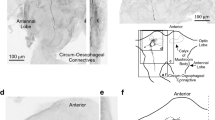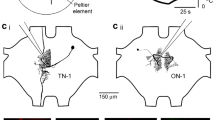Summary
-
1.
A high-frequency auditory neurone (HF1AN) was identified morphologically and physiologically in the prothoracic ganglion of the cricket,Gryllus bimaculatus DeGeer.
-
2.
The main inputs of the HF1AN are from the lateral and medial parts of the auditory neuropile ipsilateral to the axon and to a lesser extent, the medial part of the contralateral auditory neuropile. The single axon ascends to the brain and the soma is located either near the base of the anterior connective or close to the base of nerve N1 contralateral to the axon (Fig. 1).
-
3.
The HF1AN is sensitive to sound stimulation in the whole range of tested (from 2 to 100 kHz) frequencies. The neurone is not tuned to a particular frequency and has greatest sensitivity in the range 13–25 kHz (Fig. 2). At frequencies below 10–12 kHz the neurone receives additional inhibitory inputs which greatly modify its response pattern from phasic-tonic with prolonged discharge to phasic with an inhibitory pause (Figs. 3–4). The inhibitory effect is intensity dependent and its frequency range varies between animals. In the range of frequencies where the inhibitory effect is pronounced, sound stimulation evokes suppression of activity during the sound pulse and increase of activity between the pulses. On the contrary, at high frequencies the cell gives a burst of spikes to each sound pulse and background activity (if present) is suppressed after each burst for at least 1–2 s (Figs. 5, 6).
-
4.
The HF1AN responds in a phasic-tonic manner to pure high-frequency tones of long duration (1,300 ms) throughout the whole intensity range (Fig. 7).
-
5.
The HF1AN responds strongly to high-frequency ticks of the courtship song of conspecific males and to the location sounds of sympatric bats (Fig. 8).
-
6.
Both anatomical and physiological properties indicate that the HF1AN may belong to the neuronal circuits controlling evasive behavior and/or arousal of the cricket.
Similar content being viewed by others
Abbreviations
- CLB :
-
contralateral branches
- LSAN :
-
large segmental auditory neurone
- PF :
-
primary auditory fibre
References
Boyan GS, Williams JLD (1981) Descending interneurons in the brain of the cricket. Anatomy and responses to auditory stimuli. Naturwissenschaften 67:486–487
Boyan GS, Williams JLD (1982) Auditory neurons in the brain of the cricketGryllus bimaculatus (De Geer). II. Ascending interneurons. J Comp Physiol
Casaday GB, Hoy RR (1977) Auditory interneurons in the cricketTeleogryllus oceaniens: Physiological and anatomical properties. J Comp Physiol 121:1–13
Cokl A, Kalmring K, Wittig H (1977) The responses of auditory ventral-cord neurons ofLocusta migratoria to vibration stimuli. J Comp Physiol 120:161–172
Elsner N, Popov AV (1978) Neuroethology of acoustic communication. Adv Insect Physiol 13:229–355
Kleindienst, H-U, Koch UT, Wohlers D (1981) Analysis of the cricket auditory system by acoustic stimulation using a closed sound field. J Comp Physiol 141:283–296
Konstantinov AI, Makarov AK (1973) Echolocating signals of some native species of bats (Vespertilionidae). In: Airapetianz ES (ed) Problems of comparative physiology of analyzers, vol 3, Echolocation in bats. University Press, Leningrad, pp 29–44
Kühne R, Lewis B, Kalmring K (1980) The responses of ventral cord neurons ofDecticus verrucivorus (L) to sound and vibration stimuli. Behav Proc 5:55–74
Miller LA, Degn HJ (1981) The acoustic behaviour of four species of vespertilionid bats studied in the field. J Comp Physiol 142:67–74
Moiseff A, Hoy RR (1981) Sensitivity to ultrasound in an identified auditory interneuron in the cricket: a possible neural link to phonotactic behaviour. J Comp Physiol
Moiseff A, Pollack G, Hoy RR (1978) Steering responses of flying crickets to sound and ultrasound: Mate attraction and predator avoidance. Proc Natl Acad Sci USA 75:4052–4056
Popov AV, Shuvalov VF (1977) Phonotactic behaviour of crickets. J Comp Physiol 119:111–126
Popov AV, Shuvalov VF, Markovich AM (1975) Spectrum of the calling songs, phonotaxis and the auditory system in the cricketGryllus bimaculatus. Zh Evol Biokhim Fiziol 11:453–460
Popov AV, Markovich AM, Andjan AS (1978) Auditory interneurons in the prothoracic ganglion of the cricket.Gryllus bimaculatus de Geer. I. The large segmental auditory neuron (LSAN). J Comp Physiol 126:183–192
Rehbein H-G (1975) Untersuchungen zur funktionellen Anatomie der Hörbahn vonLocusta migratoria (Acrididae, Orthoptera). Diss thesis, Ruhr-University Bochum
Rehbein H-G (1976) Auditory neurons in the ventral cord of the locust: morphological and functional properties. J Comp Physiol 110:233–250
Rheinlaender J, Kalmring K, Popov AV, Rehbein H-G (1976) Brain projections and information processing of biologically significant sounds by two large ventral-cord neurons ofGryllus bimaculatus de Geer (Orthoptera, Gryllidae). J Comp Physiol 110:251–269
Shuvalov VF, Popov AV (1971) The reaction of females of the domestic cricketAcheta domestica to sound signals and its changes in ontogenesis. Zh Evol Biokh Fiziol 7:612–616
Tyrer NM, Bell EM (1974) The intensification of cobalt-filled neurone profiles using a modification of Timms sulphide-silver method. Brain Res 73:151–155
Wiese K (1981) Influence of vibration on cricket hearing: interaction of low-frequency vibration and acoustic stimuli in the Omega neuron. J Comp Physiol 143:135–142
Wohlers D, Huber F (1978) Intracellular recording and staining of cricket auditory interneurons (Gryllus campestris L.,Gryllus bimaculatus De Geer). J Comp Physiol 127:11–28
Wohlers D, Huber F (1982) Processing of sound signals by six types of neurons in the prothoracic ganglion of the cricket,Gryllus campestris L. J Comp Physiol 146:161–173
Author information
Authors and Affiliations
Rights and permissions
About this article
Cite this article
Popov, A.V., Markovich, A.M. Auditory interneurones in the prothoracic ganglion of the cricket,Gryllus bimaculatus . J. Comp. Physiol. 146, 351–359 (1982). https://doi.org/10.1007/BF00612705
Accepted:
Issue Date:
DOI: https://doi.org/10.1007/BF00612705




